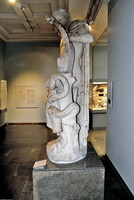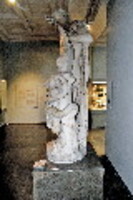| dc.coverage.spatial | Site: British Museum (London, England, United Kingdom) GR 1861.7-25.1 (Sculpture 1380) | en_US |
| dc.coverage.temporal | 2nd century CE (creation) | en_US |
| dc.creator | unknown (Ancient Roman) | en_US |
| dc.date | 100-199 | en_US |
| dc.date.accessioned | 2013-01-29T20:22:24Z | |
| dc.date.available | 2013-01-29T20:22:24Z | |
| dc.date.issued | 100-199 | en_US |
| dc.identifier | 189548 | en_US |
| dc.identifier.other | archrefid: 1745 | en_US |
| dc.identifier.uri | http://hdl.handle.net/1721.3/98084 | |
| dc.description | Side view; This colossal marble statue came from the Temple of Apollo at Cyrene in modern Libya. The statue of Apollo was found broken into 121 pieces, laying near the large pedestal on which it had originally stood. The fragments were painstakingly removed from the site and reassembled in the British Museum. The Roman patrons who commissioned the statue were encouraged by the emperor Hadrian to celebrate their civic identity by evoking the city's Greek past. Source: British Museum [website]; http://www.britishmuseum.org (accessed 6/14/2009) | en_US |
| dc.format.medium | marble | en_US |
| dc.rights | © Scott Gilchrist, Archivision, Inc. | en_US |
| dc.subject | deities | en_US |
| dc.subject | music | en_US |
| dc.subject | mythology (Classical) | en_US |
| dc.subject | Apollo (Greek deity) | en_US |
| dc.subject | archaeology | en_US |
| dc.subject | Performing arts | en_US |
| dc.subject | lyre | en_US |
| dc.subject | musical instrument | en_US |
| dc.subject | himation | en_US |
| dc.subject | serpent | en_US |
| dc.subject | Greco-Roman | en_US |
| dc.subject | Imperial (Roman) | en_US |
| dc.subject | Hellenistic | en_US |
| dc.title | Colossal marble statue of Apollo | en_US |
| dc.title.alternative | Apollo holding a kithara | en_US |
| dc.type | image | en_US |
| dc.rights.access | Licensed for educational and research use by the MIT community only | en_US |
| dc.identifier.vendorcode | 7A3-G-BM-AHK-A2 | en_US |
| vra.culturalContext | Ancient Roman | en_US |
| vra.technique | carving (processes) | en_US |
| vra.worktype | sculpture (visual work) | en_US |
| dc.contributor.display | unknown (Ancient Roman) | en_US |



